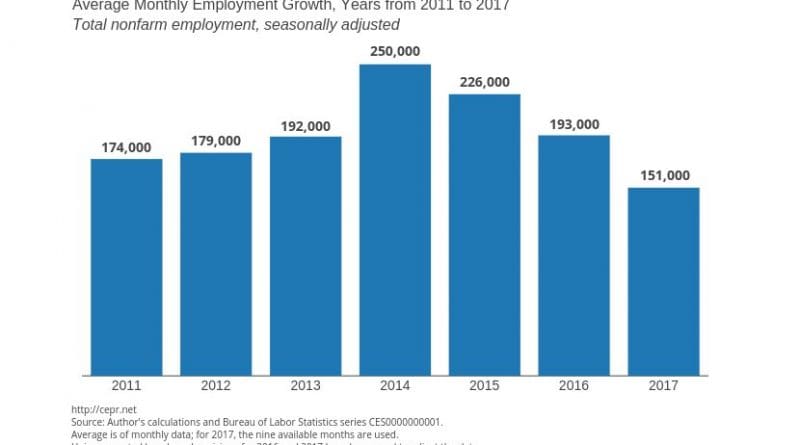Hurricanes Cause Job Loss, But Household Survey Points To New Low in Unemployment Rate – OpEd
By Dean Baker
Employment fell by 33,000 in September, according to the Bureau of Labor Statistics establishment survey, the first decline since September of 2010. The drop was due to the effects of the hurricanes in Texas and Florida. This is shown clearly from the loss of 104,700 jobs in restaurants. Offsetting this bad news, the household survey showed the unemployment rate falling to 4.2 percent, a new low for the recovery. This was due to a reported surge in employment of 906,000. This increased the employment-to-population ratio (EPOP) to 60.4 percent, a new high for the recovery. The household data are erratic (reported employment fell 74,000 in August), so this jump is likely to be at least partially reversed next month.
Trying to pull out the effects of the hurricane is difficult. One item that is disturbing was a downward revision to the August job growth number by 51,000, going from 189,000 to 138,000. Since the reference period was the middle of the month, this was not the result of the hurricanes. The rate of job growth was already substantially below the 193,000 monthly average for 2016 and 226,000 for 2015. The downward revision for August and the decline in September pushes the pace down further, although October is virtually certain to show a sharp rebound.
There does appear to be a substantial uptick in wage growth in the data, with the average hourly wage rising 12 cents in September. This brings the year-over-year increase to 2.9 percent. The average over the last three months compared with the average for the prior three months rose at an even more rapid 3.6 percent annual rate.
However these numbers should be viewed with some caution. The hurricanes reduced hiring in the month across the board and the newly hired are generally the lowest paid. This compositional effect can be seen with the loss of restaurant jobs. Since these jobs pay over $10 below the overall average, the loss of more than 100,000 restaurant jobs has the effect of raising the average hourly wage by roughly 1 cent. This compositional effect is occurring within every industry.
There appears to have been a similar, albeit smaller effect, in January of 1996 when severe snowstorms across the Midwest and Northeast led to a loss of 15,000 jobs. The average hourly wage for production and nonsupervisory workers (the only series available for that period) jumped by 0.5 percent that month compared with 0.3 percent in December. It was flat the following month. It is worth noting in this respect that the pay of production and nonsupervisory workers rose by 9 cents in September and is up by 2.5 percent over the last year.
In addition to the fall in overall unemployment, other data in the household survey was overwhelmingly positive. The unemployment rate for blacks fell to 7.0 percent, tying the low hit in April of 2000, which is the lowest number on record. The EPOP rose to 58.2 percent, half a percentage point higher than the prior peak for the recovery. The unemployment rate for black women fell to 6.0 percent, the lowest on record.
The employment rate for prime age (ages 25–54) workers rose by 0.5 percentage points to 78.9 percent — a new high for the recovery but a level that is still 1.4 percentage points below the prerecession peak and 3.0 percentage points below the peak hit in 2000. The 85.5 percent EPOP for prime-age men is a new high for the recovery, while the 72.4 percent rate for women ties the peak hit in July.
The number of people who are incorporated and self-employed jumped by 145,000 to a new high. The average for 2017 is 460,000, or 8.6 percent, above the average for 2013. An increase in self-employment is one of the predicted effects of Obamacare since ending dependence on employer-sponsored insurance allows people to start their own business.
In spite of the hurricane-caused drop in employment, there is much positive news in this report, especially the continuing rise in employment rates for prime-age workers. However, it will be difficult to get a better sense of the underlying trends in employment and wage growth until we see the data for October.

